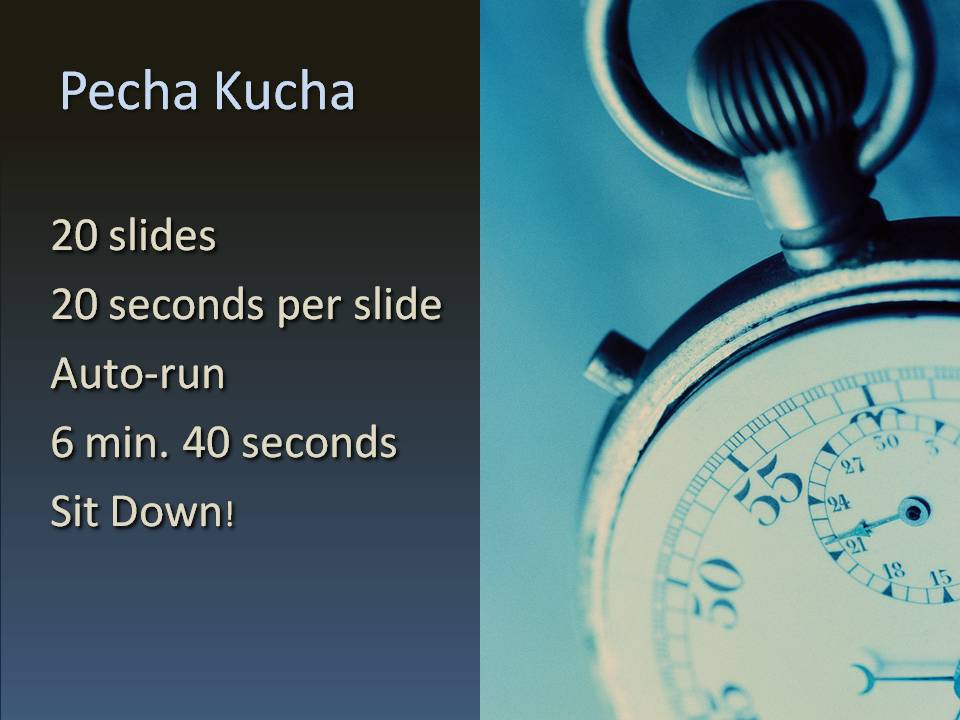How Many Minutes Is The Audience’s Attention Span?
Editor’s note: This is part four of our five-part series, The Psychology of Public Speaking. All five posts in this series are excerpted from 100 Things Every Presenter Needs To Know About People by Susan Weinschenk.
Imagine you’re in a meeting and someone is presenting sales figures for the last quarter.
How long can she hold your attention? If the topic is of interest to you and she is a good presenter, you can focus on the presentation for 7 to 10 minutes at most. If you’re not interested in the topic or the presenter is particularly boring, then you’ll lose interest much faster—possibly you’ll tune out within 7 seconds instead of minutes.
If people have a short break, then they can start over with another 7- to 10-minute period, but 7 to 10 minutes is the longest block of time they will pay attention to any one presentation.
WHY IGNITE! AND PECHA KUCHA ARE SO POPULAR
If you’ve ever been to an “Ignite!” or Pecha Kucha presentation “jam,” you would likely agree that the 7-to-10-minute rule holds.
These are meetings in which presenters come together to give short presentations in a very structured format. For an Ignite session, each presenter has 5 minutes to present 20 slides, or 15 seconds each. The slides are automatically advanced, so speakers have to live by the rules. Pecha Kucha presentations are similar; they have 20 slides that display for 20 seconds each.
At these events, there is a succession of presentations by different speakers. I recently attended an Ignite session that went for 1.5 hours and had 15 different speakers. One reason why Ignite and Pecha Kucha sessions work well is that each presentation is under the 7-minute mark. When you get a new presenter and new topic every 5 minutes, it is easier to pay attention.
BUILD IN TRANSITIONS AND MINI-BREAKS
A typical presentation is longer than 7 to 10 minutes. Presentations are often an hour long. This means you have to find ways to make changes at least every 7 minutes in order to get people to pay attention.
It’s easy, as the presenter, to forget that your audience’s attention may be waning. As the presenter, you are having a very different experience than your audience: You have adrenaline flowing because you are on stage, you are in the throes of a performance, and you are physically moving. The members of your audience, on the other hand, are sitting in chairs, and their minds are easily wandering.
6 WAYS TO CREATE MINI-BREAKS
In order to keep attention, you have to introduce some kind of change at least every 7 minutes. There are many ways to do this, and they can be small and subtle. Here are some ideas:
1. Have a mini-break. If your session is longer than 60 minutes, you need to have some kind of break. This doesn’t have to be a long, 20-minute break. You can use a 5-minute stretch break too.
2. Do something interactive. In my talks, I build in small exercises that can be done no matter how many people I’m presenting to. For example, during one of my presentations, I show a picture of an old-fashioned faucet with two handles, one for hot water and one for cold water. I ask the audience to write down which way they would turn the handles to get lukewarm water to come out of the faucet. Then we go through all the possibilities (there are four ways to turn the handles), and I ask for a show of hands for each method. I use the results to introduce the next topic, which is about mental models.
3. Ask the audience a question. If you take a minute to ask the audience a question, that will serve as a break. If it’s a large group, you can ask questions that require only a show of hands (“How many of you have…”).
4. Move to a different position. Rather than pacing around the front of the room or on the stage, stay in one area for a few minutes and then walk to a different place and speak from there. You can do this more often than every 7 minutes, as long as you are not continuously moving around (which makes you seem nervous).
5. Move on to a different topic. Stop and say, “Now, I want to talk about something that is very different.”
6. Tell a story. Stories grab attention instantly. Sprinkle interesting stories throughout your presentation. Make sure the stories are short and relevant to the topic at hand.
Copyright © 2012. Used with permission of PearsonEducation, Inc. and New Riders.
Interested in purchasing 100 Things Every Presenter Needs To Know About People? You can find the soft cover here and the Kindle edition here.





Great article! Some fiery tips for the presenters to grab the attention of their audience. Never been a part of Pecha Kucha presentation, but this 7-10 minutes theory really works well.
Mini breaks are very important, as people lose their interest if the presentation exceeds more than 10 minutes in a stretch . To keep your audience engaged you can make them participate in ice breakers (if the group is small) or just as the author said, ask them a question.
To be a successful presenter, you should really know these facts.
Thanks for sharing this article, Brad.
Arpit
authorSTREAM Team
Arpit,
Thank you very much for your comment – I’m glad you found the article useful. It’s nice to have you as part of the blog’s community!
Thanks for reading,
Brad
[…] The average attention span of an audience is 7 minutes. Thus, the audience – students and business people alike – will only pay attention to a topic for 7 minutes, after that a change should be made to maintain audience attention. […]
I desire to write a history book(a dull subject) of the world. It will be in 17 second paragraphs because that, to me, is the average attention span of the target audience I hope to attract. I have already hand written seven volumes and am just now approaching “Constantine”. Any suggestions? JBP
The topic changes in less than one minute, but maintains coherence for the length of a chapter!
[…] Phillips, B. (2012). How Many Minutes Is The Audience’s Attention Span? | Mr. Media Training. Mrmediatraining.com. Retrieved 16 May 2016, from https://www.throughlinegroup.com/2012/08/23/how-many-minutes-is-the-audiences-attention-span/ […]
[…] the end of the day draws near, crowds at conference can be restless and attention spans can be short. So don’t try to be too clever or complicated. Keep your talk simple and to the point. Feel free […]
[…] paying attention at the very beginning of your presentation. During the middle of your presentation it’s already dropped down to 10-20% of the people who were listening at the beginning. By the end of the presentation people have come […]